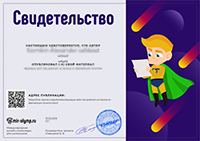LESSON PLAN
| LESSON: Unit 5. Creativity. Reading and listening to stories and legends | SCHOOL: #173 school-lyceum | ||||||
| DATE: | TEACHER NAME: Акbubek Kulbaeva | ||||||
| CLASS: 5 | NUMBER PRESENT: | ABSENT: | |||||
| Learning objective(s) that this lesson is contributing to: | 5.R1 understand the main points in a limited range of short simple texts on general and curricular topics 5.R2 understand with little support specific information and detail in short, simple texts on a limited range of general and curricular topics 5.S8 recount basic stories and events on a range of general and curricular topics | ||||||
| Lesson objectives: | All learners will be able: To pronounce proper names correctly To reorder cards to create the story Most learners will be able: To explain the use of present and past tenses Some learners will be able: Speak about Kazakh legend | ||||||
| Language objective: | Present and past tenses | ||||||
| Assessment criteria: | peer/group assessment | ||||||
| Value links: | | ||||||
| Cross curricular links: | literature | ||||||
| ICT skills: | PPT | ||||||
| Previous learning |
| ||||||
| PLAN | |||||||
| Planned timings | Planned activities | Resources | |||||
| Beginning
5min
| Checking up the hometask Setting the aim of the lesson
Phonetic drill: (W) Learners look at names of people in King Arthur story on board and listen to pronunciation: 1. Who is in story? Merlin (= magician and King Arthur’s friend) Guinevere (= King Arthur’s wife) Lancelot ( = a brave knight) , Galahad ( = a brave knight) , 2. Where does the story happen? Camelot ( = castle) Avalon ( = place where they sleep and wait to rescue people) 3. What is the name of the sword? (Excalibur)
|
Slide 3 PPP
| |||||
| Middle 15min
10min
|
Reading (P/G) Students are divided into pairs (or groups), given worksheetsand asked to colour them and cut out the pieces. (colours are pointed at the bottom of the card in the worksheet, students use this colour code to match and connect the cards to make up a coherent text. As colours are repeated students should pay attention to punctuation, as well as the logical syntax of the sentences)
Peer assessment Every pair/group correct their peers’ text and comment on their work.
Students are asked to read and write the text on the board
Extra: Teacher dictates a short version of a Kazakh legend in English. Learners draw some of the things they hear about in the legend. |
Worksheets. Scissors, crayons or coloured pencils
Nixon, C. and Tomlinson, M. (2003) Primary Grammar Box Cambridge: CUP (p. 106, p.107
| |||||
| End 5min
| Feedback: Learners give their own opinion on the learnt material |
| |||||
| Additional information | |||||||
| DIFFERENTIATION – how do you plan to give more support? How do you plan to challenge the more able learners? | ASSESSMENT – how are you planning to check learners’ learning? | Cross-curricularlinks
| |||||
| More-abled students support less-abled students More-abled students are given extra tasks
| Thumbs up if they understood everything /thumbs down- didn’t understand/ thumbs left or right – understood 50 percent | literature | |||||
| Reflection Were the lesson objectives/learning objectives realistic? What did the learners learn today? What was the learning atmosphere like? Did my planned differentiation work well?
Did I stick to timings? What changes did I make from my plan and why?
| Use the space below to reflect on your lesson. Answer the most relevant questions from the box on the left about your lesson. | ||||||
|
| |||||||
| Summary evaluation
What two things went really well (consider both teaching and learning)?
1:
2:
What two things would have improved the lesson (consider both teaching and learning)?
1:
2:
What have I learned from this lesson about the class or individuals that will inform my next lesson?
| |||||||


 549
549 18
18 Reading and listening to stories and legends
Reading and listening to stories and legends 